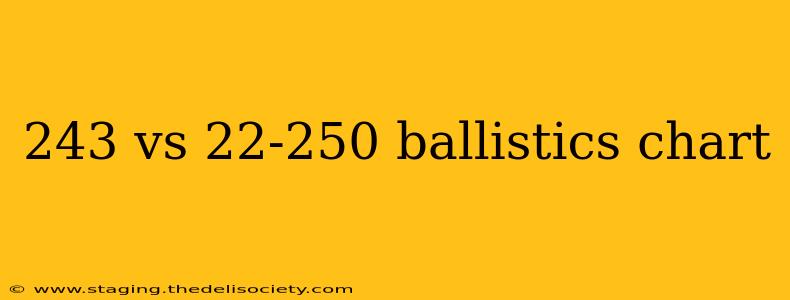243 vs 22-250 Ballistics Chart: A Detailed Comparison for Hunters and Shooters
Choosing the right cartridge for hunting or target shooting can be a daunting task. Two popular choices often debated are the .243 Winchester and the .22-250 Remington. Both offer impressive performance, but their distinct ballistic characteristics make them suitable for different applications. This article will delve into a comprehensive comparison of the .243 Winchester and the .22-250 Remington, focusing on their ballistic performance to help you make an informed decision. We won't be providing a downloadable ballistics chart, as those are readily available from various ammunition manufacturers and ballistic calculators, but we will analyze the key differences.
Understanding Ballistics: Key Factors to Consider
Before diving into the comparison, let's briefly touch upon the key ballistic factors that distinguish these cartridges:
- Velocity: This measures the speed of the bullet as it leaves the barrel. Higher velocity generally translates to flatter trajectory and longer range.
- Energy: This represents the bullet's kinetic energy upon impact, directly impacting its stopping power.
- Trajectory: This refers to the bullet's flight path. A flatter trajectory is desirable for longer-range shots as it minimizes the need for significant elevation adjustments.
- Recoil: The amount of force felt by the shooter upon firing. Higher velocity cartridges typically produce more recoil.
.243 Winchester Ballistics: A Versatile Choice
The .243 Winchester is known for its versatility. It offers a good balance of velocity, energy, and manageable recoil, making it a popular choice for hunting various game animals, from deer to coyotes. Its relatively flat trajectory allows for accurate shots at moderate ranges. While not as powerful as some larger calibers, its accuracy and manageable recoil make it suitable for new shooters as well as experienced hunters.
Key Strengths:
- Lower Recoil: Easier to manage for new shooters and for extended shooting sessions.
- Good Accuracy: Known for its accuracy and consistency.
- Versatile Hunting Cartridge: Suitable for a wide range of game animals.
.22-250 Remington Ballistics: The Speed Demon
The .22-250 Remington is renowned for its incredibly high velocity. This makes it an excellent choice for long-range shooting and varmint hunting. Its flat trajectory extends its effective range significantly compared to the .243 Winchester. However, the higher velocity also translates to more noticeable recoil. The smaller bullet diameter also limits its effectiveness on larger game animals.
Key Strengths:
- High Velocity: Exceptional speed for long-range accuracy and flat trajectory.
- Excellent for Varmint Hunting: Ideal for prairie dogs, groundhogs, and other small pests.
- Long-Range Capability: Its high velocity allows for accurate shots at extended distances.
.243 Winchester vs .22-250 Remington: A Direct Comparison
The table below summarizes the key differences (Note: these are general comparisons and specific values will vary depending on the ammunition manufacturer, bullet weight, and barrel length):
| Feature | .243 Winchester | .22-250 Remington |
|---|---|---|
| Velocity | Moderate | Very High |
| Energy | Moderate | High (for its caliber) |
| Recoil | Moderate | Higher |
| Trajectory | Relatively Flat | Extremely Flat |
| Hunting Use | Deer, Antelope, Coyotes, Hogs | Prairie dogs, groundhogs, coyotes |
| Target Shooting | Suitable for various target distances | Excellent for long-range target shooting |
Choosing the Right Cartridge: Consider Your Needs
Ultimately, the best cartridge for you depends on your specific needs and intended use.
-
Choose the .243 Winchester if: You need a versatile cartridge with moderate recoil, suitable for a range of hunting applications and relatively easy to shoot.
-
Choose the .22-250 Remington if: You prioritize high velocity and long-range accuracy for varmint hunting or long-range target shooting. You are comfortable with higher recoil.
Remember to always consult relevant safety guidelines and regulations before handling firearms. This comparison provides a general overview, and further research using online ballistic calculators and manufacturer data is highly recommended for precise ballistic information tailored to your specific ammunition and firearm.
